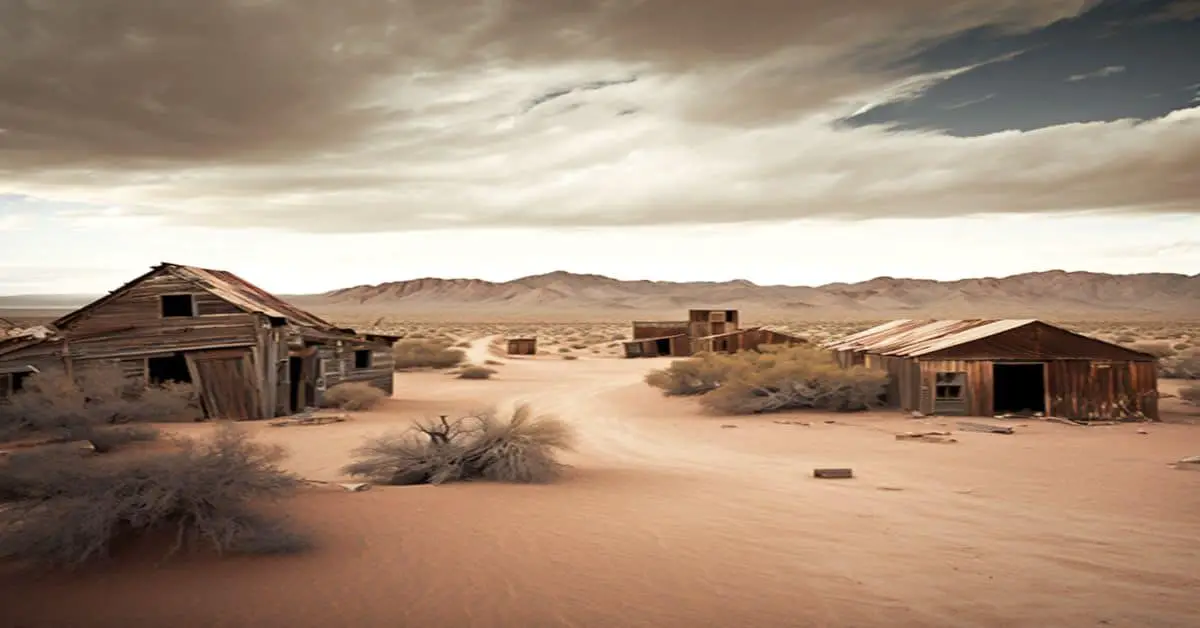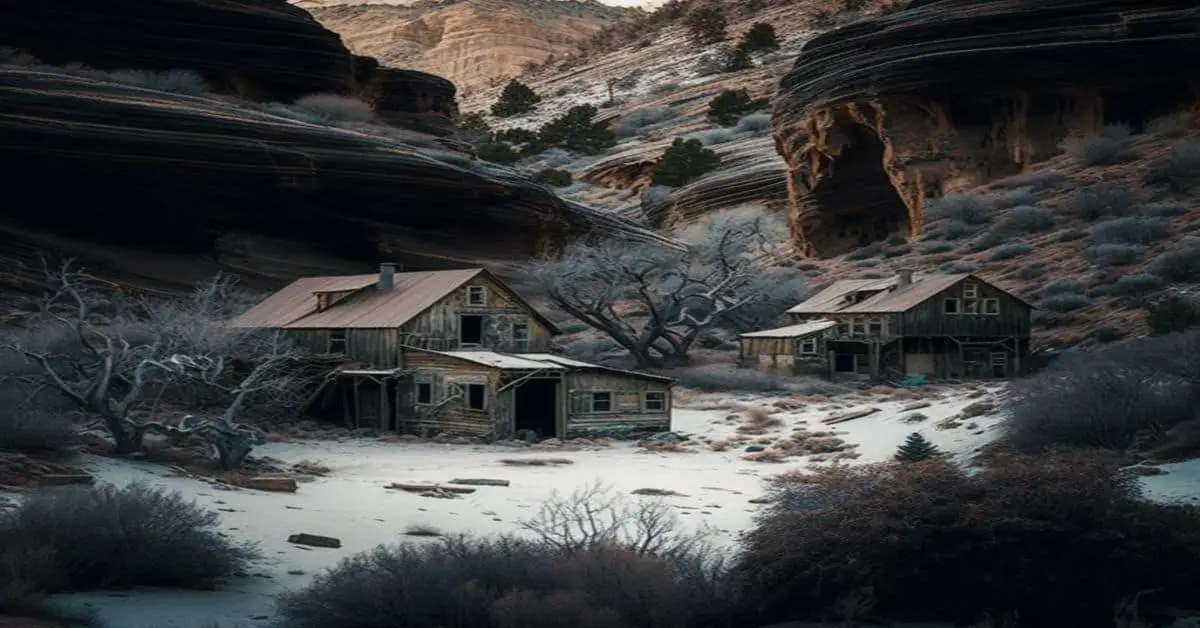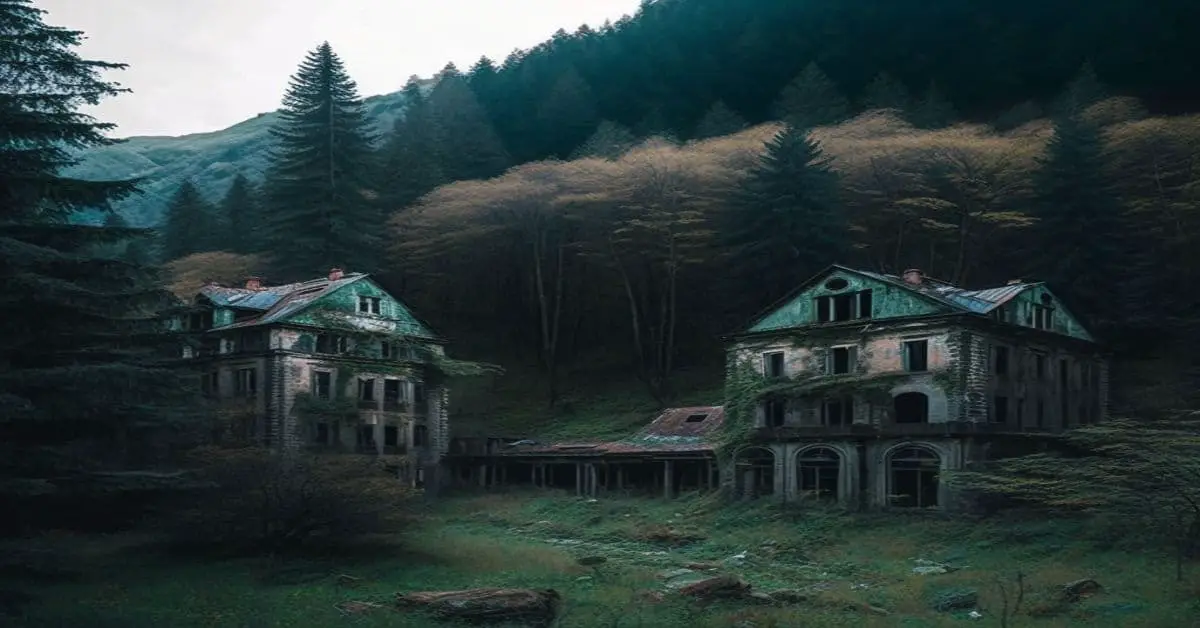As the sun sets over the arid, rocky landscape of California’s Greenwater Valley Road, the remains of four ghost towns stand as a testament to the boom and bust cycle of mining communities. Greenwater, Furnace, Kunze, and Ramsey were once bustling with life, attracting over a thousand people at their peak. However, little ore was produced, and these towns were abandoned by 1908. Today, they are a fascinating reminder of the past, with remnants of the towns scattered across the desert landscape.
Nestled within a five-mile belt off of Greenwater Valley Road, these towns offer a glimpse into the history of California’s mining industry and the people who lived and worked in these harsh conditions. Exploring these lost ghost towns is a must for anyone interested in history, adventure, or just seeking a unique experience.
The present-day ruins offer a fascinating insight into the once-thriving communities, from debris and cans to rotting lumber, mine shafts, and stone ruins. This article will delve into the location and climate, history and boom, and present-day ruins of these lost ghost towns, providing readers with an informative and descriptive overview of these fascinating remnants of California’s past.
Key Takeaways
- Greenwater, Furnace, Kunze, and Ramsey are ghost towns within a five-mile belt off Greenwater Valley Road in California.
- Greenwater was a booming town that grew to over 1000 people in the early 1900s, but little ore was produced and the boom was over by 1908.
- Ramsey was platted a couple of miles southeast of Greenwater Valley to provide more space and the entire population of Kunze and Furnace moved there.
- Debris, cans, rotting lumber, mine shafts, and stone ruins remain in the townsites, and photos of the townsites, mining camp, and mine shafts exist.
Location and Climate
While the townsites of Greenwater, Furnace, Kunze, and Ramsey may have been abandoned and left to debris, their location within a five-mile belt off of Greenwater Valley Road continue to provide a hot summer climate and pleasant or cold winter weather, making autumn, winter, or spring the best time to visit.
The area’s climate offers numerous tourism opportunities such as hiking, camping, and exploring the historic townsites. Visitors may also have the opportunity to see local wildlife, such as the desert tortoise, bighorn sheep, and coyotes, in their natural habitat.
Additionally, the location of the townsites provides a unique experience for visitors as they can explore the area’s rich history while enjoying the stunning desert landscape. The townsites, mining camp, and mine shafts offer a glimpse into the area’s mining boom and subsequent bust.
The debris, cans, rotting lumber, and stone ruins serve as a reminder of the once-thriving communities that existed in the area. Overall, the location and climate of Greenwater, Furnace, Kunze, and Ramsey offer a unique opportunity for visitors to explore California’s lost ghost towns while experiencing the beauty of the Mojave Desert.
History and Boom
The history of the townsites is marked by a brief but intense boom fueled by speculation and the stock market. Greenwater, originally claimed in the 1880s, was developed in 1904 and grew to over 1000 people by early 1906. The frenzy was fueled by speculation and the stock market, despite little ore produced. However, the boom was over by 1908, and the last mine closed in 1911.
Ramsey, platted a couple of miles southeast of Greenwater Valley, was established to provide more space, and the entire population of Kunze and Furnace moved here. Streets were made 150 feet wide to avoid conflagration, and the Greenwater Cemetery was located nearby.
Debris, cans, rotting lumber, mine shafts, and stone ruins remain in the townsites. The Auto Club of Southern California erected a sign in Greenwater about 1908, and a few of the original signs are still found on old trails and early auto routes in the Mojave Desert. However, the sign is unrecognizable due to modern redecorating utilizing desert scrap, spray paint, and shotgun.
It is interesting to note the impact of the stock market frenzy on the development of Greenwater, Furnace, Kunze, and Ramsey and how it contributed to the rise and fall of these ghost towns.
Present Day Ruins
Symbolic remnants of a bygone era can be found scattered throughout the deserted townsites of Greenwater, Furnace, Kunze, and Ramsey. These ghost towns now lay barren and empty, with abandoned structures and rusted machinery serving as a reminder of the once-bustling communities driven by the hope for wealth and prosperity.
The townsites have been left to decay over the years, and the harsh desert climate has taken its toll on the buildings, leaving broken windows, caved-in roofs, and crumbling walls in its wake.
Despite the deterioration of the ghost towns, preservation efforts have been made to protect what remains of these historic sites. The Bureau of Land Management has designated the Greenwater Valley and its surrounding areas as a cultural resource management district to preserve the historic and archaeological sites in the area.
Visitors are encouraged to explore the townsites and learn about the region’s history, but are also reminded to respect the sites by not disturbing or removing any artifacts or structures. Through these preservation efforts, the ghost towns of Greenwater, Furnace, Kunze, and Ramsey will continue to serve as a reminder of California’s once-thriving mining industry.
Frequently Asked Questions
How did the towns get their names, and what is their significance?
The origins of the names of the ghost towns Greenwater, Furnace, Kunze, and Ramsey were influenced by their geographic location in California’s Mojave Desert. Furnace was named for the nearby hills, while Greenwater referred to the greenish tint of nearby water. Kunze was named after a local prospector, while Ramsey was named for a prominent resident. Transportation access was a key factor in the development of these towns, with three railroads planned to reach Greenwater.
What were the demographics of the towns, and what kinds of people lived there?
The demographics of Greenwater, Furnace, Kunze, and Ramsey were diverse, with miners, shopkeepers, and other laborers comprising most of the population. Economic activities revolved around mining, with social structures reflecting the transient nature of the towns.
Were there any notable events or tragedies that occurred in the towns during their existence?
Several tragic events occurred in the California ghost towns of Greenwater, Furnace, Kunze, and Ramsey during their brief existence. Abandoned artifacts such as debris, cans, rotting lumber, mine shafts, and stone ruins remain as reminders of the towns’ past.
What was the impact of the towns on the surrounding environment, and how has that changed over time?
The impact of the towns on the surrounding environment was significant, with mining activities causing soil erosion, water pollution, and habitat destruction. Conservation efforts have been made to restore the area, but the changes are slow and limited.
Are there any local legends or ghost stories associated with the towns or their ruins?
Despite the eerie reputation of abandoned ghost towns, no local ghost stories or supernatural sightings have been reported in the ruins of Greenwater, Furnace, Kunze, and Ramsey. There is no evidence of any paranormal activity associated with these haunted ruins.


